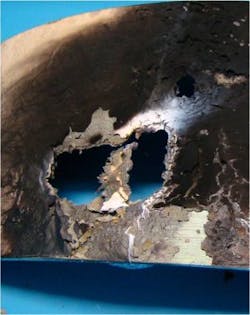Northrop Grumman demonstrates anti-cruise missile laser weapon
Redondo Beach, CA--Northrop Grumman (NYSE:NOC) tested fired the first of its Firstrike family of high-energy, solid-state lasers, demonstrating that it could burn through the skin and critical components of a target drone used to simulate anti-ship cruise missile threats to U.S. Navy ships.
"Gamma has equaled or exceeded the performance we achieved in previous slab lasers, but the real advancement here is in packaging and ruggedization for operations in real-world military platforms," said Steve Hixson, vice president of advanced concepts, space and directed energy systems for Northrop Grumman's Aerospace Systems sector.
"The Gamma demonstrator is built in a form factor that implements the size and weight reduction goals of the Firstrike design, which cuts the weight of the finished laser chain to 500 pounds and shrinks the volume to 23 inches by 40 inches by 12 inches," said Dan Wildt, vice president, directed energy systems, Northrop Grumman Aerospace Systems. The Firestrike laser, announced in 2008, forms the backbone near-term laser weapon systems from Northrop Grumman.
Gamma implements a significant reduction in the number of internal optical components, while new mounting techniques eliminate sensitivity to vibrations. Key portions of the Gamma laser have already been subjected to vibration, shock and thermal testing to validate that these improvements have achieved design goals. The Gamma demonstrator is a single "chain" or building block that is designed to be combined with other chains to create laser systems of greater power, as was demonstrated in Northrop Grumman's 105 kW Joint High Power Solid State Laser.
The lethality testing used a single Gamma chain at short distance in a way that simulated the effects that a laser weapon of several chains aboard a Navy ship could achieve at a range of several miles. The components used in the test included the skin of a surplus BQM-74 drone and other parts configured to represent critical internal components. The BQM-74 was formerly produced by Northrop Grumman for the Navy as a representative cruise missile threat and used for testing defensive systems.
About the Author

Conard Holton
Conard Holton has 25 years of science and technology editing and writing experience. He was formerly a staff member and consultant for government agencies such as the New York State Energy Research and Development Authority and the International Atomic Energy Agency, and engineering companies such as Bechtel. He joined Laser Focus World in 1997 as senior editor, becoming editor in chief of WDM Solutions, which he founded in 1999. In 2003 he joined Vision Systems Design as editor in chief, while continuing as contributing editor at Laser Focus World. Conard became editor in chief of Laser Focus World in August 2011, a role in which he served through August 2018. He then served as Editor at Large for Laser Focus World and Co-Chair of the Lasers & Photonics Marketplace Seminar from August 2018 through January 2022. He received his B.A. from the University of Pennsylvania, with additional studies at the Colorado School of Mines and Medill School of Journalism at Northwestern University.
